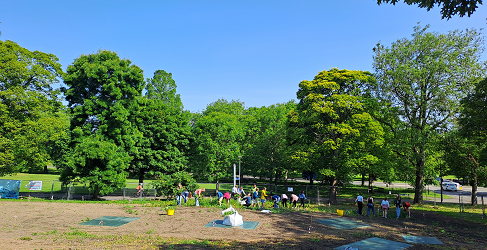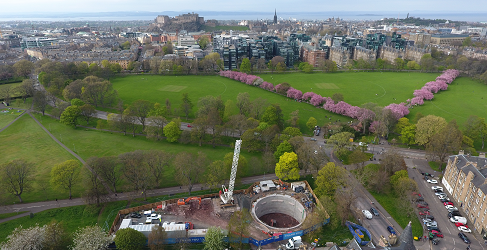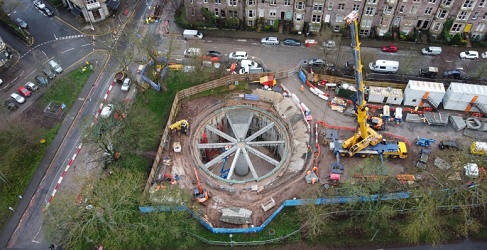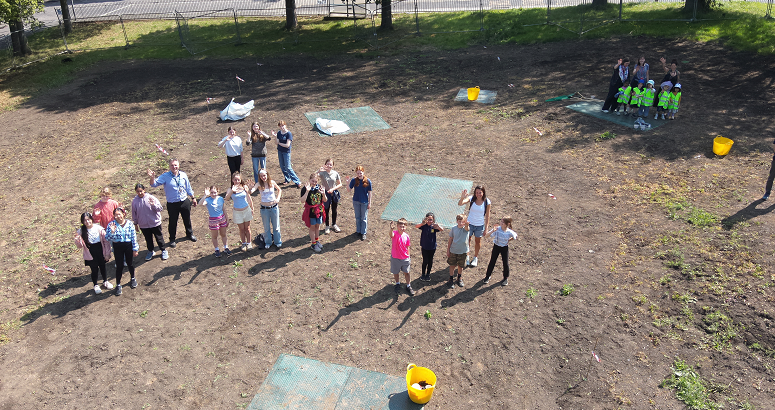Edinburgh community sows seeds for the future on site of key project
12 June 2025Community effort
Our major investment in Marchmont's waste water network was celebrated at a meadow planting event
A multi-million pound investment by Scottish Water in Edinburgh’s waste water network has been marked by a community effort to sow the seeds of what will become a large wild meadow above the site of a key project.
Community groups and school pupils took part in an event this week, to plant the meadow which will cover ground on Bruntsfield Links in Marchmont. A 20-metre-deep storm tank has been installed underground as part of the investment to help protect customers from sewer flooding.
Members of Friends of the Meadows and Bruntsfield Links joined forces with pupils from James Gillespie's High School, James Gillespie's Primary School and Viewforth Early Years Centre to sow the new meadow with a special wildflower seed mix that will help nature thrive.
Creation of the wildflower meadow was led by Dr Tim Duffy, Chair of the Scottish Wildlife Trust’s Lothians Members Group and David Kyles of the City of Edinburgh Council. It will take around a year to establish, during which time fencing will remain around the perimeter of the site.

School pupils took part in the event to plant the meadow

The planting took place in stunning sunshine
Scottish Water’s investment in the waste water network has been designed so storm water will be directed to the underground tank during heavy rainfall, something which occurs more frequently due to climate change.
Once the storm has subsided, storm water collected in the tank will then be pumped out to the sewer network and carried to the waste water treatment works before being returned safely to the environment. Ultimately, this means that for customers in the area, the risk of flooding has been reduced. In addition, over 600 metres of new sewer pipe has been fitted beneath Marchmont Crescent.
Early on in the project it was agreed that the site should be re-established as a wildflower meadow upon completion. In 2015, experts from Brechin-based Scotia Seeds, the University of Edinburgh and the Scottish Wildlife Trust designed a wildflower seed mix specifically for urban pollinators such as bees which need help to source food throughout the summer. To ensure effectiveness, it was trialled on sites including the existing much smaller meadow adjacent to the new site.
Construction of the storm tank was a feat of engineering, and dramatic drone footage shot during the process shows the scale of this underground giant.

The storm tank shown during construction

The site as it is today, with the meadow planted above the tank
Rob Mustard, Scottish Water's Director of Capital Investment said:“The improvements will benefit customers and the environment for years to come.”
Rob Mustard
Scottish Water's Director of Capital Investment
“Completion of this multi-million pound investment in Edinburgh’s waste water network reflects Scottish Water’s commitment to improving its infrastructure to better serve our customers, meet increased demand and address the impact of climate change.
“The improvements made to the sewer network and installation of the storm tank will benefit customers and the environment in Marchmont for years to come.
“We are grateful to everyone who has worked with us to allow us to carry out this work. Their patience and understanding is greatly appreciated.”
All cabins have now been removed but fencing will remain in place while the seed is established. Following completion, timber used for the site hoarding was donated to local schools.
The project was delivered by Scottish Water’s alliance partner Caledonia Water Alliance (CWA).
Paul Milligan, CWA’s Communications Manager said:
“This has been a huge piece of engineering in the heart of Edinburgh. We are very glad to have successfully completed the project and provide peace of mind for properties that were affected by flooding.
“The new storm tank will be able to hold around 3.5 million litres of storm water. When you see the sheer scale of the storage tank you get an appreciation of the amount of storm water that will be held back from the local sewer network during periods of heavy rainfall. We overcame challenges such as excavating out extremely dense sandstone for the tank construction to tunnelling a section of sewer to avoid mature tree roots.
“We would like to thank the whole community for their patience throughout the whole project over the last two and half years. We have enjoyed working with the community and giving back to them, from our timber wood donations to local schools, to showing round the Beaver Scouts during construction. Our dedicated teams have worked tirelessly to deliver this major new piece of infrastructure that will benefit this historic part of Edinburgh for decades to come.”

Drone footage showing the storm tank during construction

Beaver Scouts visited the site
“This will become one of the biggest urban pollinator meadows in the centre of Edinburgh. A true meadow beside the Meadows.”
Dr Tim Duffy
Chair of the Scottish Wildlife Trust's Lothian Members Group
Dr Tim Duffy, Chair of the Scottish Wildlife Trust’s Lothians Members Group said:
“We have designed an Urban Pollinator Mix specifically for urban pollinators such as bees, hoverflies and butterflies which need help during the summer.
“Many wildflower seed mixes have gaps in the nectar source through the year, but this one has been specifically designed so that food is provided to pollinators through to October.
“It will take a year but once the site is established people will be able to hear the buzzing of the bees. It will become one of the biggest urban pollinator meadows in the centre of Edinburgh. A true Meadow beside the Meadows.
“I’d like to thank Scottish Water and the City of Edinburgh Council for supporting the naturalisation of green spaces in Edinburgh.”
Culture and Communities Convener at the City of Edinburgh Council Margaret Graham said: “It’s fantastic to see the completion of this important project which will significantly reduce the risk of sewer flooding in the area.
"Protecting our communities and preparing of the impacts of climate change remain our top priorities. The creation of such a large meadow will be hugely beneficial for insects and other pollinators, support our response to the climate emergency and is progress in our Thriving Greenspaces 2050 Vision and Biodiversity Action Plan.”









